
There are a number of firearm companies that play on the reputation of historical firearms when there is no association of substance; Springfield Armory with its reference to a long defunct government facility, Kahr Arms with the use of the Thompson and Auto Ordinance names, and the manufacturer of the subject rifle, Henry Repeating Arms. It’s common, smart business, but a practice I don’t particular like to see. As a minimum, it is disingenuous and misleading to consumers.
The Henry rifle’s place in history actually goes something like this. During the Henry rifle’s last full year of production, 1865, New Haven Arms became the Henry Rifle Company as the result of a dissident shareholders’ take over bid. While Oliver Winchester was abroad on a product sales and promotion tour, his corporate secretary Charles Nott entered into a collaboration with Benjamin Henry. Misusing the intent of a power of attorney assigned by Oliver Winchester, they petitioned the Connecticut Legislature to change the name of the company to the Henry Rifle Company.
Beyond the appearance of a business betrayal, it was a poorly thought out strategy on the part of Henry. Oliver Winchester controlled directly and through alliances a majority of the company’s stock and had personally invested $300,000 in the New Haven operation, recorded as secured loans. Additionally, Winchester owned the New Haven, CT manufacturing facility where Henry rifles were manufactured and he owned at least half of the production equipment used to manufacture Henrys 1) 3).
When the dust settled, a new facility in Bridgeport Connecticut was opened as the Winchester Arms Company with Nelson King installed as factory superintendent. Nott was sent packing from New Haven Arms and Henry was left to his own devices and spending his time threatening litigation. Within two years, the books closed on New Haven Arms and all assets and intellectual property from Hunt to Henry were absorbed by the Winchester Company. King set out to overhaul the Henry design and to give the company its first Winchester rifle. It came in the form of the Winchester Model 1866. 1) 4)
A different Henry company
The Henry Repeating Arms company was formed in 1996. Unlike the old Henry Rifle Company, it has been a business success to the extent of becoming the largest producer of lever action firearms in the United States. Headquartered in Bayonne, NJ where the company maintain a 100,000 sq ft of manufacturing space, in 2014 Henry expanded into an additional 138,000 sq ft manufacturing facility in Rice Lake, WI. Henry employs 300+ people and ships in excess of 300,000 firearms per annum 5).
Commendably, while Henry has it’s share of blatant celebrity/politician photo op promotions and endorsements, Henry also uses the success of its business to raise significant money for numerous charities and benevolent organizations including those addressing children’s health care and health care facilities, veterans and shooting and other outdoor sports.
I’d guess both Remington and Winchester have contributed greatly to Henry’s success. Remington by purchasing Marlin. Marlin, a company already struggling with quality issues and no obvious future strategy did not need to have Remington’s sloppy learning curve put on public display or left to languish in a marketing black hole. Competition waits for no one. Winchester seems content to purchase high grade lever guns from Japan and keep them in short supply to keep prices up and to keep products in demand.
Henry product overview…
Other than a sense of firearm nostalgia and appreciation for its role in our history, I don’t really get that excited about the original 1860 Henry. It is a weak toggle link design and chambered for an under powered .44 caliber rimfire cartridge. The rifle has no forearm, which puts the hot hardware of a much fired rifle in the palm of the shooter. The rifle has no receiver loading gate, which means an inability to have the rifle at the ready when the tubular magazine is being filled. Ejection is through the top of the rifle’s receiver. It was a great firearm in its day, but this is… not then.
Henry Repeating Arms, as an accommodation to Cowboy Action Shooters, collectors and folks who embrace but may not be able to afford history, did add a Henry 1860 replica to their product line up in 2014. Brass or steel receiver, chambered for the 44-40 WCF, and priced at $2,300 and $2,750 respectively, these are not exactly a casual purchase. Uberti manufacturers a number of versions of the 1860 Henry, chambered in either 44-40 WCF or 45 Colt with an MSRP approximately $1,000 lower than the Henry Repeating product. I have not compared one manufacturer’s products to the other, so I cannot say if the price differential represents value or quality differenced. In any event, the 1860 Henry replicas are exceptions within the Henry product lines as the balance of the products are of a more modern and stronger design and chambered for more powerful cartridges.
|
Henry Big Boy Steel Carbine |
|
| Company | Henry Repeating Arms |
| Point of Manufacturer | Rice Lake, WI |
| Model # | H012CR |
| Type of Action | Lever |
| Caliber | 45 Colt |
| Magazine Capacity | 7 |
| Magazine Type | Tubular |
| Barrel Length | 16.5″ |
| Rifling Twist Rate | 1:38 |
| Barrel/Receiver Material | Alloy Steel |
| Trigger Type | Non-Adjustable |
| Trigger Pull | 4 Lbs 14 Oz. |
| Stock Material | Walnut |
| Length of Pull – Actual | 14 1/8″ |
| Drop at comb | 1 1/2″ |
| Drop at heel | 2″ |
| Front Sight | Brass Bead |
| Rear Sight | Semi Buckhorn |
| Scope Accommodation | Drilled & Tapped |
| Weight of Firearm – Actual | 6 1/2 Lbs |
| Overall Length – Actual | 35 1/8″ |
| Safety | Transfer Bar |
| MSRP | $850 |
Henry offers a myriad of standard production, tribute and special edition rifles, with chambers ranging from the 17 HMR to the 45-70 Government. Receivers are made of steel or brass, dependent upon model. Some firearms are quite plain, some quite fancy, many are good fit for Cowboy Action shooting events, some are a good fit for collectors, others are quite suitable for hunting. The case at hand…
The Henry Repeating Arms Big Boy Steel Carbine has a design very similar to the Marlin 336; closed top receiver, cylindrical breech bolt, vertical locking bolt, bolt wrapping extractor, spring loaded ejector, etc. Missing in comparison to the Marlin is the side loading gate, replaced by a forward loading tubular magazine, similar to the original Henry method of loading.
The current carbine has a hand filling forearm, an enlarged lever loop to accommodate gloved hands and optionally chambered for the: 357 Magnum/38 Special, 41 Remington magnum, 44 Remington Magnum/44 Special, or the 45 Colt.
A few things related to what appears in the spec box that warrant comment or will be looked at a little more closely in Part 2. I spoke with Henry regarding the use of +P 45 Colt ammo, specifically Buffalo Bore and Cor-Bon. I was told the ammunition was not a problem up to 260 grains, unfortunately, the support person was unable to explain the basis for the weight restriction and there was no further information was in the offering.
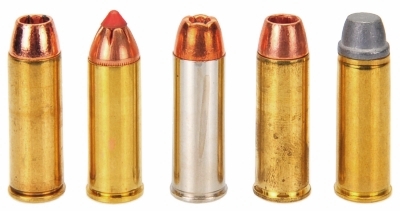
So at this point I don’t know is the weight is metaphor for feed length limitations or an issue of the rifle’s very slow twist rate not stabilizing heavier, longer bullets and having a negative impact on accuracy. In any event, we’ll run a bunch of factory ammo to check mechanical clearances and check accuracy and see what happens. Twist rates and Greenhill don’t directly address the key to stability; appropriate rotational speed and rate and time of acceleration.
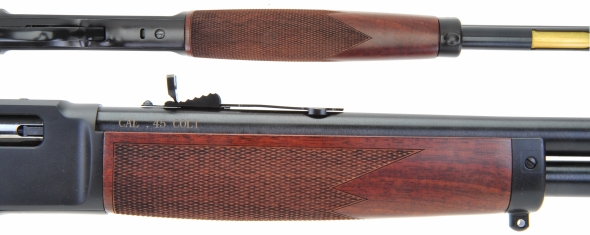
The Henry may be a short barrel carbine, but it is not a lightweight. In fact it weighs about a pound more than a 20″ barrel, short action Marlin 1894 and about half a pound more than a 20″ barrel, short action Winchester Model 1892. My personal opinion is that it is weight well spent.
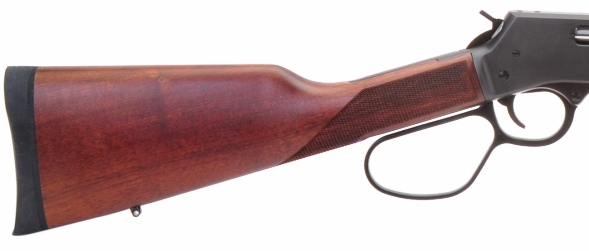
The stock set is hand filling and the checkering is well placed and patterned. Unlike the current crop of competing lever guns, the Henry does not feel like a 2×4. Instead it feels balanced, steady and it is aesthetically pleasing. The length of full is a bit long, but not excessively so and the rifle goes quickly to the shoulder… no, not on its own but in a natural motion.
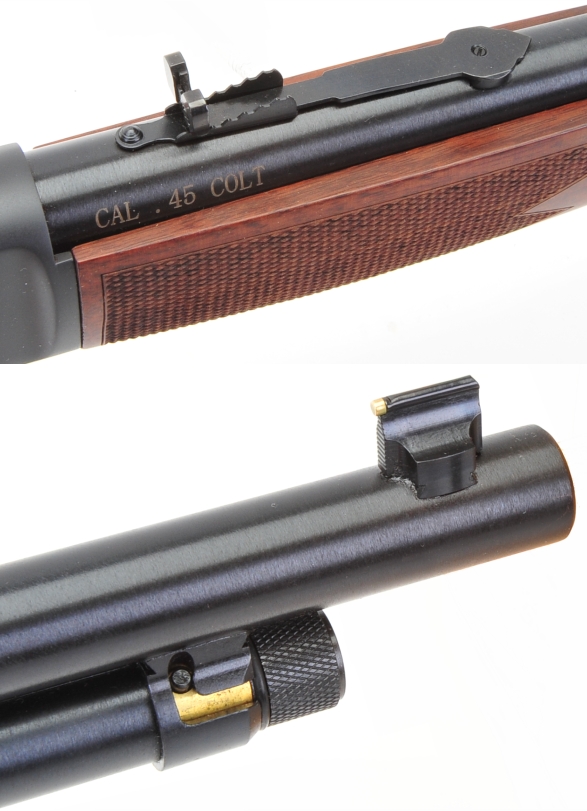
The sight set is appropriate and quite sturdy, both are dovetail mounted. The brass bead, serrated face and tapered post front sight kills glare and stands out in sharp contrast to most backdrops. The rear sight vertical adjustment is, coarse, by raising or lowering the light leaf on the sight elevator, fine, by raising or lowering the rear sight insert. Rear sight windage adjustment is drift adjustable.
I am not yet sure how I feel about the finish and textures. The stocks are excellent; checkering, color and fit. This rifle was pulled from distribution inventory, not a selected loaner from the manufacturer, and it has the tightest and cleanest inletting I’ve seen on a production lever action in a very long time.
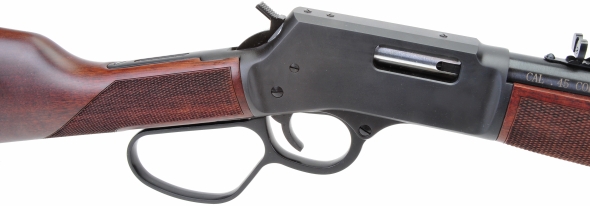
I like the shape of the lever, even though I usually dislike oversize levers outside of old TV shows. In this case it does make carrying with gloves or without gloves easier. The metal finish is a little busy; fine bead blasted all over receiver, gloss lever and a blued barrel finish that looks like it was finished with a too coarse carding or polishing wheel or that someone applied too much uneven pressure when prepping for bluing. Might just be that I look at a lot of firearms so I notice small differences. Overall, it is a good looking little carbine, finished a level above its price.
We’ll take a short break, finishing looking at the rifle and log range results for Part 2.

Email Notification